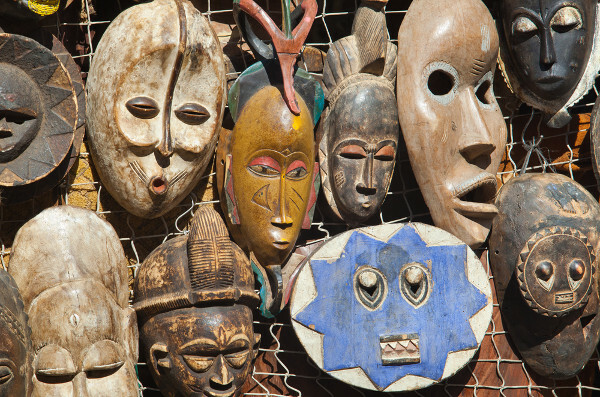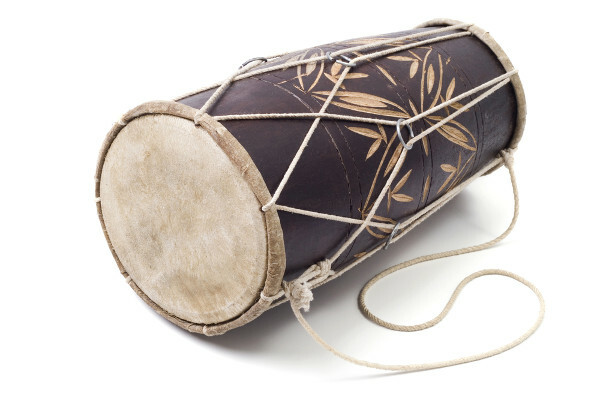African cultureit is vast and diverse, endowed with enormous immaterial wealth, a factor that is explained so much by the diversity of ethnic groups present in the Africa as well as the influence of Middle Eastern and European peoples who had contact with Africans throughout history. The combination of migratory factors, European colonization and diversity ethnic in the interior of the continent has made Africa currently a continent in which several languages are spoken and several are worshiped religions and which is characterized by being multicultural.
Know more: Brazilian culture: from diversity to inequality
African cultural diversity
The African continent can be Dividedgeopolitically in two large swaths of land: a AfricaSaharan (northern region) and the Africasub-Saharan (South region). Both are regions of cultural diversity, but the southern portion of the continent is more diverse and contains most of the population.

THE North region, Saharan, has maintained, throughout history, forced and spontaneous contacts with peoples Phoenicians, Turks, Arabs, Romans, Greeks and the Far East. It is situated in an arid area, just above the Saara's desert, and is made up of countries like Egypt, Morocco, Tunisia, Libya and Algeria.
They live on this portion of land about 30% of the continent's population, and most of these inhabitants worship the Islam, followed by a Christian minority. The people who live there have peculiar phenotypic traits, arising from the mixture between peoples of the Middle East, blacks and white, where they are not white like the natural peoples of Europe or black like the natural peoples of Africa sub-Saharan region.
Before we understand the cultural diversity of sub-Saharan Africa, we must dispel a prejudice that many carry with them about the southern portion of the continent. Misery, hunger, disease and social inequality they are not part of the ancient history of Africa.
Sub-Saharan Africa is made up by people of different ethnicities who led a tribal way of life. Among the various ethnic groups, we highlight the Bantu, Nagô and Jeje peoples, brought to Brazil during the Colonial period. War between tribes was common, and they worshiped different religions with a similar matrix, based on worship to the orixás — entities that in African mythology have a spiritual contact with nature and represent the connection and protection of natural elements or human beings.
currently, there is a large portion of the population of southern Africa who maintain their roots and worship the religions traditional traditions, but there are also a significant number of Muslims and Christians living in the region. cause religious conflicts arising from prejudice and intolerance, especially on the part of Christians and Muslims.
The ailments that affect the African people today are the result of the colonization process in two cycles:
Colonialism
Led mainly by Portugal and Spain, it sought in sub-Saharan Africa people to be enslaved in the colonies and meet the needs of agricultural and mining labor. In this process, just as European countries took natural wealth from their colonies located in the Americas, they also confiscated African natural wealth.
Another feature of this first colonization was the intentional incitement, by the Europeans, of internal conflicts between African tribes, in order to obtain, through agreements with the victorious tribes, the capture of slaves who had been defeated in the war so that they could be sent to the colonies. It was a common custom among the tribes that the victors captured the vanquished as slaves.
This system of slavery was, however, quite different from slavery with a European bias, as Africans saw themselves, even in a master and slave relationship as equals, while Europeans saw Africans as inferior.
neocolonialism
O neocolonialism (or imperialism) was a second wave of colonization that literally divided sub-Saharan Africa and some countries in the Asia and Oceania among the main European powers. Most of the African continent came under the dominion of england, there are also countries under the Portuguese and French domains. This factor brought about a division of borders and the formation of national states in the region.
The problem is that these states housed different ethnicities and tribes, with different religions and cultures, and that were historically enemies. This caused several internal conflicts and civil wars that marked the history of the continent and contributed to the poverty of the local population. Other factors that caused the misery were the rampant withdrawal of natural resources from mining, such as gold and diamonds, and hunting, which depleted natural resources in various parts of the continent.
Read too: Ethnocentrism - a point of view that values one ethnicity over another
African cultural traditions
Among the cultural traditions, we can highlight some as the most striking and widespread. We separate and expose below sections with the traditional marks of African peoples.
Habits and customs
Among the northern peoples of the continent, the habits and traditionally islamic customs, as this religious denomination is predominant over there. It is common in societies, especially the Egyptian and the Moroccan, the prevalence of the use of the veil for the Muslim women and the institution of a patriarchal model of family, based on the customs of the Islam.
already the southern peopleshave a culture wider and, consequently, more diversified. In some places, Christian culture is predominant, especially in those that colonization established itself with greater force, like South Africa. In others, such as Congo, Mozambique, Sierra Leone, Somalia and Kenya, the prevalence of the way of life tribal in the interiors is still striking, which reminds us of the native polytheistic religions still existing.
visual arts
The southern African peoples developed several connected art forms, principally, to your religions. These are artifacts, such as masks, braided rope, figurines and others, carved in wood, stone or made from fabrics. The symbolism of these artistic forms refers to deities or everyday elements and have different meanings for each people, representing the sacred, the profane or actions that are part of the culture, such as war and food gathering (most sub-Saharan tribes had a nomadic life, based on hunting and gathering, before the arrival of Europeans on the continent).

At sculptures in ivory of the Bakongo peoples evidence the traditional hunting of elephants, animals that were once abundant in some parts of Africa, for food. The tusks of these animals are made of a dense, calcified material, ivory, and were used to make sculptures and adornments, such as necklaces.
The peoples who inhabited the regions of savanna (biome present in much of sub-Saharan Africa) knew the metallurgy, casting metals to fabricate hunting and war weapons, Besides decoration artifacts.
Song and dance
THE song and the dance they are part of African tribal cultures. Packed by a rhythm marked by percussion instruments, African dances usually have fast pace and beat, which allows for different variations and movements.
Both arts often have religious connotations and are used to mark traditional cults, being elements that attract and please the orixás (or good spirits) and drive away evil spirits. Music and dance are also used in tribes in celebrations and festivals, being practiced by all members.
Some rhythms of African origin are the capoeira (a mixture of martial art and dance), the drumming, O lundu it's the coconut. Many Western musical rhythms originated from African music, such as samba, axé and maracatu in Brazil; O reggae in Jamaica; it's the Jazz in the United States.
Typical instruments of African culture for the composition of music are:
Atabaque: A percussion instrument made from wood and animal leather, usually played with the hands, can also be played with thin wooden sticks. It is used today in capoeira, samba, axé and maracatu, among other rhythms.

berimbau: Angolan instrument composed of a wooden bow, a wire rope and a gourd box, which amplifies the sound resulting from the vibration of the string. The berimbau is played with a stick, made of some sturdy wooden stick, and is usually accompanied by a rattle, which moves the rod, and a stone, which holds the berimbau and serves to interrupt the vibration of the rope. In Angola, the berimbau is known as m’bolumbumba. The instrument has been used, since its creation, in capoeira, to produce the typical sounds that the capoeiristas dance into.
agogo: is a metal instrument that has two or more bells (the outside of a bell without the bell, which is the internal pendulum) of metal and of different sizes, held by a rod also of metal. A metal or wooden stick is used to vibrate the bells, which produce the sound.
afoxe: it is a kind of rattle made with a gourd and a braided net with threads and seeds. The net covers the gourd, but remains loose, so as to allow friction between the seeds and the gourd when moved, which generates the sound amplified by the gourd.
Read too: Cultural historical heritage: cultural and scientific legacy of a society
Afro-descendant culture in Brazil
African culture arrived in Brazilian lands by Africans brought here to serve as slaves. You slave ships or tumbeiros (large European vessels that carried in their holds tens and even hundreds of Africans in degrading conditions) carried people of various African ethnicities, which allowed for cultural plurality of African origin in Brazil.
With the fusion between African culture and the various elements of indigenous culture and European, a very vast culture was born in the country. If we search in our origins, there are several elements that make up our traditional training and originate from the African continent.
Candomblé and Umbanda
They are originally Brazilian religions, but which arose based on African religious elements. Candomblé is the cult of the Yoruba culture's orixás, while Umbanda is a syncretic form between Candomblé, Catholicism and Kardecist spiritism.

cuisine
Our cuisine is full of dishes and ingredients from African culture or created by Africans in Brazil. We can list the acarajé, the vatapá, the abará and the caruru. Despite the common belief that the feijoada has its roots in the culture of enslaved Africans in Brazil, its uncertain origin seems to point out that, at least as it is done today, it was not a creation of slaves.
First, as the Brazilian historian and folklorist Luís da Câmara Cascudo defends, many slaves were muslims, and the Islamic religion bans the consumption of pork by his followers for considering him an impure animal. Second, jerk beef and pork, even the least coveted pieces today like the ear, tail, muzzle and paw, were of great value, due to the difficulty in raising the animals and conserving their meat in the Colonial Period, which distances the thesis that these pieces were served to slaves.
The historian Carlos Alberto Dória points out that the feijoada as we know it today was created in Brazilian restaurants in the 19th century and has its origins in “fat beans”, which consist of beans cooked with dried meat.
Dance
Today we have several Brazilian dances that were brought by Africans or emerged based on cultural elements of these people who lived in Brazil. They are: the capoeira, which is also a martial art used as a defense of fugitive slaves against forest captains; O samba; O axe, dance originating from the afoxé rhythm that originates from traditional religious dances); O coconut; it's the maracatu.
see more: Dance – history, rhythm and movement
by Francisco Porfirio
sociology professor
Source: Brazil School - https://brasilescola.uol.com.br/cultura/cultura-africana.htm


